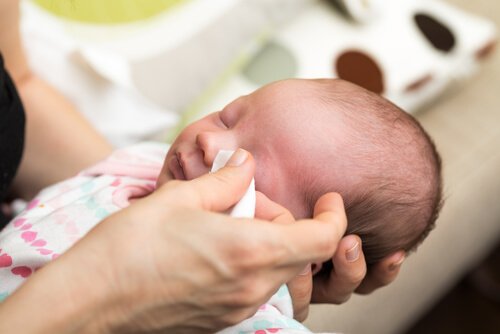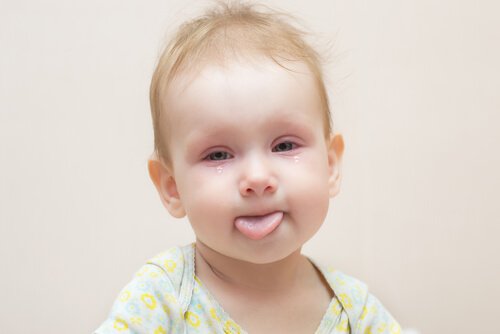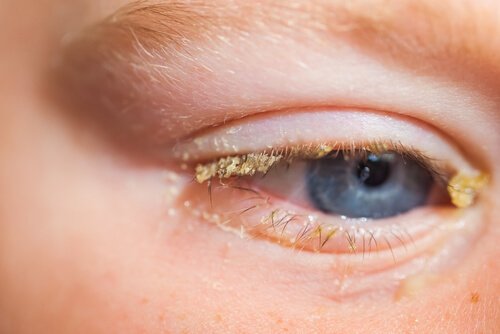Conjunctivitis in Babies: Causes, Symptoms and Treatment

In this article we’ll share with you everything you need to know about conjunctivitis in babies and older children in order to help you solve the problem quickly and effectively.
Conjunctivitis occurs frequently in older children. It’s nothing more than the inflammation of the conjunctiva. The conjunctiva is the membrane that covers the white part of the eyes and the inner part of the eyelids. It is transparent and therefore, imperceptible to the naked eye.
Symptoms of conjunctivitis in babies
- Constant tearing.
- Sensitivity to light.
- More eye secretion than usual.
- The appearance of white, yellow or greenish eye secretions.
- Eye inflammation, especially around the white part of the eye and the eye lids. It can be difficult for parents to determine exactly what part of their child’s eye is inflamed. What is evident however, is the general inflammation.
- Red eyes. The white part and lower edges of the eyes redden. This may occur in one eye or in both.
- Itchiness or the sensation of having sand or “something” in the eyes. Since newborns still aren’t able to communicate how they feel, mothers should observe if their babies are constantly trying to scratch their eyes.
It is important to go to the pediatrician as soon as one or several of the symptoms mentioned above are noticed.

Types of conjunctivitis in babies
Conjunctivitis can be classified according to its origin. It can also be classified according to the child’s age, as characteristics and treatment regimens may vary.
Chemical conjunctivitis
This can be caused by the eye drops that are administered to the baby at the moment of birth. The drops are applied to prevent bacterial infections. Chemical conjunctivitis is usually quite mild. The inflammation and redness of the eyes usually disappears after approximately 36 hours. It doesn’t require medical treatment.
Conjunctivitis due to Neisseria Gonorrhea
This is also known as gonococcal conjunctivitis, It is caused by the gonorrhea bacteria and transmitted to the baby as it passes through the birth canal. If the mother has gonorrhea, the baby is prone to suffer from conjunctivitis due to Neisseria Gonorrhea
Conjunctivitis due to Chlamydia trachomatis
This is also known as conjunctivitis due to inclusion. It can also be transmitted through the birth canal. Symptoms such as inflammation, redness and eye discharge usually appear 5 days after birth. It can be treated with oral antibiotics.
Bacterial conjunctivitis
Several types of bacteria can cause conjunctivitis in babies and children. Treatment depends on the specific type of bacteria that causes it.
The most common symptoms are swollen eyes and yellowish secretions that cause the eyelids to stick together. The best treatment for bacterial conjunctivitis is antibiotic drops or creams.
Doctors also recommend cleaning the eyes with warm compresses. When cleaning your child’s eyes, take all of the possible hygienic measures.

Common causes of conjunctivitis in babies and children
- Blocked lachrymal duct. Many babies are born with one or two blocked lachrymal ducts. The symptoms are often confused with those of conjunctivitis. After a few days, the child’s eye may become infected due to a lack of lubrication. Pediatricians often perform specific massages to treat this condition. In the most severe cases, a simple surgical procedure may be performed.
- Bacteria. They reach the eye easily since they live on the skin of the surrounding structures. The most commonly found bacteria include: staphylococcus, streptococcus and haemophilus.
- Viruses. Viruses are the most common causes of conjunctivitis.
- Allergies. Allergies due to dust, pollen, smoke or any other external agent may cause conjunctivitis.
- Contact with irritants. Any foreign element can cause eye irritation. It may happen for example due to creams, chlorine from swimming pools, perfume or any other substance that comes into contact with the child’s eyes.
What to do when confronted with conjunctivitis
The first thing you should do is contact your pediatrican who will determine whether the child requires antibiotics or antihistamines, depending on the origin of the conjunctivitis. It is also important to avoid using homemade remedies without previously contacting your doctor.
In addition, to avoid contagions, anyone who is in charge of taking care of the child should wash their hands meticulously before and after being in contact with the child’s eyes.
Viral and bacterial conjunctivitis are very contagious. These measures will also help protect the other children at home.